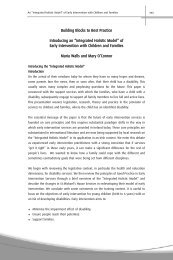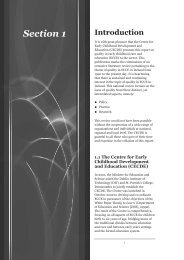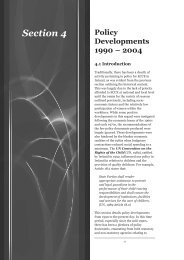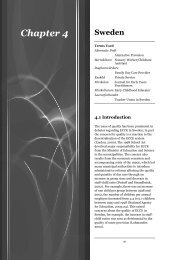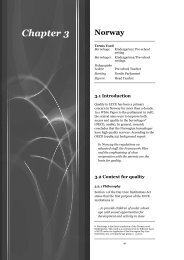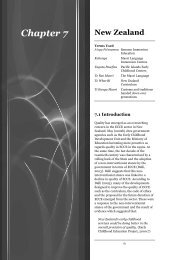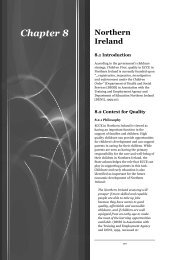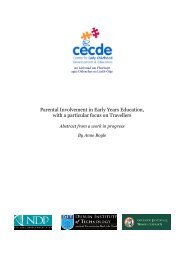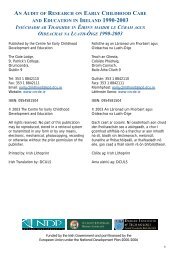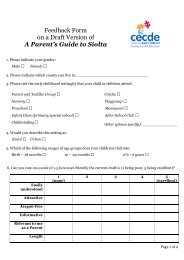Early Years Provision - Centre for Early Childhood Development ...
Early Years Provision - Centre for Early Childhood Development ...
Early Years Provision - Centre for Early Childhood Development ...
Create successful ePaper yourself
Turn your PDF publications into a flip-book with our unique Google optimized e-Paper software.
CECDE Research Series 2006<br />
<strong>Early</strong> <strong>Years</strong> <strong>Provision</strong><br />
<strong>for</strong> Children from<br />
Birth to Six <strong>Years</strong><br />
with Special Needs<br />
in Two Geographical<br />
Areas in Ireland
CECDE Research Series 2006<br />
<strong>Early</strong> <strong>Years</strong> <strong>Provision</strong> <strong>for</strong> Children from Birth to Six <strong>Years</strong> with Special Needs in Two<br />
Geographical Areas in Ireland<br />
Executive Summary<br />
Project Team: Research Associates:<br />
Emer Kelleher Dr Georgina Julian (from September 2004 to February 2005)<br />
Anne McGough Georgia Dissou (from February 2005 to July 2005)<br />
Dr Jean Ware<br />
Special Education Department, St Patrick’s College, Drumcondra, Dublin 9<br />
We would like to thank all those who helped us in many ways in the completion of this report,<br />
in particular Frances Halligan and Celine O’Connell.<br />
Research Commissioned and Funded by the <strong>Centre</strong> <strong>for</strong> <strong>Early</strong> <strong>Childhood</strong> <strong>Development</strong><br />
and Education.<br />
The full report may be accessed online at http://www.cecde.ie/english/targeted_projects.php<br />
The views expressed in this report are the authors’ and do not necessarily reflect those of the <strong>Centre</strong> <strong>for</strong> <strong>Early</strong><br />
<strong>Childhood</strong> <strong>Development</strong> and Education.<br />
Published by the <strong>Centre</strong> <strong>for</strong> <strong>Early</strong> <strong>Childhood</strong> <strong>Development</strong> and Education<br />
The Gate Lodge,<br />
St. Patrick’s College,<br />
Drumcondra,<br />
Dublin 9.<br />
Tel: 353 1 8842110<br />
Fax: 353 1 8842111<br />
Email: early.childhood@spd.dcu.ie<br />
Website: www.cecde.ie<br />
ISBN: 0-9551894-5-4<br />
ISBN-13: 978-09551894-5-6<br />
© 2006 The <strong>Centre</strong> <strong>for</strong> <strong>Early</strong> <strong>Childhood</strong> <strong>Development</strong> and Education<br />
All rights reserved. No part of this publication may be reproduced, stored in a retrieval system or transmitted in any<br />
<strong>for</strong>m or by any means, electronic, mechanical, photocopying, recording or otherwise without the prior permission of<br />
the publisher.<br />
Funded by the Irish Government and part financed by the European Union under the National <strong>Development</strong> Plan 2000-2006
CECDE Research Series 2006<br />
<strong>Early</strong> <strong>Years</strong> <strong>Provision</strong> <strong>for</strong><br />
Children from Birth to Six <strong>Years</strong><br />
with Special Needs in Two<br />
Geographical Areas in Ireland<br />
Executive Summary
Developing and<br />
co-ordinating<br />
early childhood<br />
education<br />
in Ireland.
Table of Contents<br />
Introduction 4<br />
Research Literature 5<br />
Methodology 7<br />
Rationale 7<br />
Selection of Areas <strong>for</strong> Study 7<br />
Participants/ Identification of Providers 7<br />
Questionnaire 8<br />
Procedure/ Distribution of Questionnaires 8<br />
Key Findings and Discussion 11<br />
Providers and Children 11<br />
<strong>Provision</strong> <strong>for</strong> Children with Disabilities 11<br />
Range and Types of Disability 12<br />
Multi-Professional Services 13<br />
Disadvantage and Complexity of Need 16<br />
Measures of Intensity <strong>for</strong> Effective Intervention 16<br />
Length of Day 16<br />
Staffing Ratios 17<br />
Staff Training and Qualifications 17<br />
Family Partnership 22<br />
Recommendations 22<br />
Recommendations <strong>for</strong> Practice 22<br />
Recommendations <strong>for</strong> Policy 23<br />
Recommendations <strong>for</strong> Research 24<br />
Discussion 24<br />
References 25<br />
List of Tables<br />
Table 1: Number of questionnaires sent out and valid questionnaires returned 8<br />
Table 2: Clinical, therapeutic and other support services:<br />
Collaboration by providers that include children with disabilities 14<br />
Table 3: Qualifications of staff in each type of provider 18<br />
List of Figures<br />
Figure 1: Number of questionnaires sent out and valid questionnaires returned 9<br />
Figure 2: Number of questionnaires returned from school and other ECEC providers<br />
as a percentage of total returns 9<br />
Figure 3: Completed questionnaires received 10<br />
Figure 4: Staff qualifications 0 – 4 year olds 20<br />
Figure 5: Staff qualifications 4 – 6 year olds 20
Introduction<br />
The National Forum <strong>for</strong> <strong>Early</strong> <strong>Childhood</strong> Education (1998) was a significant<br />
milestone <strong>for</strong> children with special needs. This <strong>for</strong>um af<strong>for</strong>ded a unique<br />
opportunity <strong>for</strong> discussion on policy and practice <strong>for</strong> young children with<br />
special needs in the context of the wider debate on provision <strong>for</strong> all young<br />
children from birth to six years in Ireland. A direct outcome of the Forum<br />
was the publication of the White Paper on <strong>Early</strong> <strong>Childhood</strong> Education, Ready<br />
to Learn (Ireland, 1999) outlining Government policy in the area. Recently,<br />
there has been another major landmark with the passing of the Education <strong>for</strong><br />
Persons with Special Educational Needs Act (EPSEN) (Ireland, 2004). This act, <strong>for</strong><br />
the first time in Ireland, makes provision <strong>for</strong> young children with special needs a<br />
statutory right. In addition, the establishment of the <strong>Centre</strong> <strong>for</strong> <strong>Early</strong> <strong>Childhood</strong><br />
<strong>Development</strong> and Education (CECDE) (2002) and of the National Council <strong>for</strong><br />
Special Education (2004) has given practical expression to the aspirations and<br />
intentions outlined by policy makers so far, and has provided the institutional<br />
mechanisms through which to steer policy into practice.<br />
This executive summary sets out a condensed version of the study of <strong>Early</strong> <strong>Years</strong> <strong>Provision</strong> <strong>for</strong><br />
Children from Birth to Six <strong>Years</strong> with Special Needs in Two Geographical Areas in Ireland (McGough,<br />
Carey and Ware, 2006). It outlines the parameters of the study and the methodology used, in<br />
conjunction with its findings and recommendations. This research study was concerned with<br />
examining the nature, extent and quality of provision <strong>for</strong> children with disabilities, and <strong>for</strong> children<br />
who are at risk <strong>for</strong> reasons of socio-economic disadvantage, aged birth to six, in the Irish context.<br />
The research was commissioned and funded by the CECDE in accordance with their research<br />
strategy to undertake and/or commission research through which best practice in early years<br />
provision can be identified, implemented and evaluated. The focus and parameters of the study<br />
were decided in consultation with the <strong>Centre</strong>, in direct relation to these research objectives. The<br />
study consisted of a review of the national and international literature on early intervention and an<br />
in-depth survey of provision in two geographical regions of the country, one urban and one rural 1 .<br />
The specific objectives of the study were:<br />
(i) To review the literature in order to identify the factors which contribute to effective early<br />
intervention <strong>for</strong> children with disabilities and <strong>for</strong> children who are at risk <strong>for</strong> reasons of<br />
socio-economic disadvantage.<br />
(ii) To document provision in two geographical areas of Ireland and to provide insights in relation<br />
to the nature and quality of that provision in the context of the factors of effective practice<br />
identified in the literature review.<br />
(iii) To make recommendations in relation to future policy, research and practice in early years<br />
provision <strong>for</strong> this population of children.<br />
1. The rural area comprised counties Cavan, Long<strong>for</strong>d and Leitrim and the urban area comprised Community Care Areas Four<br />
and Five (CCA4 and CCA5). CCA4 includes; Tallaght, Crumlin, Walkinstown, Greenhills, Drimnagh, Kimmage and part of<br />
Harold’s Cross, and CCA5 includes Ballyfermot, Bluebell, Clondalkin, Inchicore, Lucan and Palmerstown.<br />
CECDE Research Series 2006
<strong>Early</strong> <strong>Years</strong> <strong>Provision</strong> <strong>for</strong> Children from Birth to Six <strong>Years</strong> with Special Needs in Two Geographical Areas in Ireland<br />
Research Literature<br />
In the context of the study, children with special needs were defined as those<br />
with a range of disabilities and those at risk <strong>for</strong> reasons of socio-economic<br />
disadvantage. This definition was drawn from the Report of the Special<br />
Education Review Committee (SERC, 1993). Consistent with the SERC Report,<br />
in this study, reference to children with a range of disabilities was intended<br />
to include children with mild, moderate, severe or profound general learning<br />
disabilities, children with motor impairment, children with sensory impairment,<br />
children with language delays and disorders, children with autistic spectrum<br />
disorder, children with emotional/ behavioural difficulties and children with<br />
multiple disabilities.<br />
The international research literature discusses provision <strong>for</strong> children with special needs and those<br />
who are at risk <strong>for</strong> reasons of socio-economic disadvantage in terms of early intervention. The<br />
concept of early intervention was born of the need to provide specific programmes of support<br />
to vulnerable children and their families at critical early stages of children’s development, usually<br />
earlier than traditional <strong>for</strong>ms of early education would be available to them (Telzrow, 1992; Barnett<br />
et al., 1999; Wolery & Bailey, 2002). The literature is unequivocal about the need to support the<br />
development of these children through effective early intervention programmes, which focus on the<br />
characteristics of the child, in the context of the family and community.<br />
It is widely accepted that research has demonstrated the general effectiveness of early intervention<br />
and is now concerned with the specific needs of individual children and their families. In this regard,<br />
two general points are constant in the current literature. For young children with disabilities, the<br />
literature points to the challenges involved in delivering an intervention practice which can meet<br />
the diverse and complex needs of children and their families (Guralnick, 2005; Odom et al., 2004;<br />
Wolery & Bailey, 2002). For children who are at risk <strong>for</strong> reasons of socio-economic disadvantage<br />
or because of minority status or both, poverty continues to be distinguished as a potent factor in<br />
defining the nature and quality of young children’s lives. Poverty exposes families and children to<br />
high-risk conditions. For families, this requires sensitive and comprehensive intervention support.<br />
Equally, in a context where families are experiencing acute difficulties, centre-based intervention can<br />
be of critical importance in children’s lives (Farran, 2000; Ramey & Ramey, 2003).<br />
The concept of early intervention was born of the<br />
need to provide specific programmes of support to<br />
vulnerable children and their families at critical early<br />
stages of children’s development, usually earlier<br />
than traditional <strong>for</strong>ms of early education would be<br />
available to them.
Consensus has arisen on a set of underlying principles or key factors which should guide early<br />
intervention programmes. <strong>Early</strong> intervention programmes must be evidence-based, must support<br />
the child’s development in the context of that child’s family and community and must integrate<br />
the contributions of multiple disciplines and agencies within a web of supports, constituting<br />
a programme which is at once comprehensive and uniquely tailored to meet the needs of<br />
individual children and their families. A key principle is that early intervention programmes<br />
should be developed in partnership with families and work with them in a dynamic relationship.<br />
This relationship should be characterised by active development of existing family strengths and<br />
sensitivity to family culture, and to the nature and extent of family needs (Guralnick, 1997; 1998;<br />
2001; 2002; Sameroff & Fiese, 2000; Farran, 2000; Wolery, 2000; Wolery & Bailey, 2002).<br />
The components of the intervention or programme follow from these broad principles<br />
(Guralnick, 1997; 2002; Wolery & Bailey, 2002). These components are:<br />
• early assessment of children and identification of risk<br />
• family consultation in relation to access to and type of services including<br />
interdisciplinary support<br />
• family involvement in services<br />
• timing of and length of exposure to the intervention<br />
• structure and length of day<br />
• curriculum approach and delivery<br />
These critical factors <strong>for</strong> effectiveness in early intervention programmes provided the framework <strong>for</strong><br />
the collection and analysis of data in this study.<br />
CECDE Research Series 2006
<strong>Early</strong> <strong>Years</strong> <strong>Provision</strong> <strong>for</strong> Children from Birth to Six <strong>Years</strong> with Special Needs in Two Geographical Areas in Ireland<br />
Methodology<br />
Rationale<br />
The key questions addressed concerned the nature of the <strong>Early</strong> <strong>Childhood</strong><br />
Education and Care (ECEC) provision available in Ireland to children aged<br />
between birth and six years. The study focused particularly on provision<br />
available to children with special needs and the extent to which this matched<br />
factors identified in the literature as characterising effective early intervention<br />
<strong>for</strong> these children.<br />
Selection of Areas <strong>for</strong> Study<br />
• Two distinct geographical regions, one urban and one rural, were selected <strong>for</strong> the study in<br />
order to sample the diversity of services available <strong>for</strong> children up to six years of age.<br />
• A relationship has been established between socio-economic factors and access to early<br />
intervention services, with families on lower incomes receiving fewer services <strong>for</strong> their<br />
children. In the Irish context, this problem can be exacerbated <strong>for</strong> families in rural areas of<br />
dispersed population. Consequently, socio-economic status and urban and rural setting were<br />
used as criteria in the selection of the areas <strong>for</strong> the study.<br />
• A number of additional demographic factors were also taken into account in designing<br />
the study. These factors were whether the area was an established one or one with a<br />
preponderance of new housing, and whether urban areas were representative of both the<br />
city and the suburbs.<br />
• A current issue in Ireland is the extent to which provision is accessible to recent immigrants<br />
to the country, particularly those whose first language is not English (or Irish). The need to<br />
ensure that this population was represented also influenced the selection of areas.<br />
Participants/ Identification of Providers<br />
There is no overall register of ECEC provision in Ireland so potential participants were initially<br />
identified from the following sources:<br />
1. Lists of ECEC provision obtained from the City and County Childcare Committees in the<br />
selected areas<br />
2. The list of schools on the website of the Department of Education and Science (DES)<br />
3. The Directory of Services <strong>for</strong> People with Intellectual Disability (2003) taken from the website<br />
of the National Association <strong>for</strong> People with an Intellectual Disability (www.namhi.ie)<br />
4. The list of ECEC providers maintained by the CECDE<br />
5. The Golden Pages<br />
6. Internet search conducted using www.google.ie<br />
A total of 700 ECEC providers was identified by these means.
Questionnaire<br />
The questionnaire was divided into four sections. Sections A and B were designed mainly to gather<br />
basic in<strong>for</strong>mation about the provision (e.g., sponsorship and funding, nature of premises). Data<br />
regarding the children being served (e.g., numbers, age range, disabilities and special needs, number<br />
of children from the Travelling community and ethnic minorities and disadvantaged areas) were also<br />
requested.<br />
Sections C and D addressed the issues of intensity emerging in the recent early intervention literature<br />
as the main factors necessary <strong>for</strong> high quality programmes:<br />
• Staff qualifications<br />
• Curriculum<br />
• Family involvement<br />
• Multi-professional services<br />
Careful consideration was given to the language used in the questionnaire. In particular, every ef<strong>for</strong>t<br />
was made to avoid using language which could be perceived as biased by any particular group of<br />
providers. Following advice from others working in the field the term ‘disability’ was used rather<br />
than special educational needs.<br />
Procedure/ Distribution of Questionnaires<br />
The questionnaire was piloted with a number of experienced Irish providers from outside the regions<br />
selected <strong>for</strong> study. In February 2005, the questionnaires were sent out and by April 2005, a total of<br />
247 valid questionnaires was returned giving an overall return rate of 35% (see Table 1/ Figure 1). All<br />
valid data from the returned questionnaires were entered and analysed using SPSS.<br />
Table 1:<br />
Number of questionnaires sent out and valid questionnaires returned<br />
Type of Providers Sent Out Returned<br />
School Providers 233 83 36%<br />
Other ECEC<br />
Providers<br />
467 164 35%<br />
Total 700 247 35%<br />
CECDE Research Series 2006
<strong>Early</strong> <strong>Years</strong> <strong>Provision</strong> <strong>for</strong> Children from Birth to Six <strong>Years</strong> with Special Needs in Two Geographical Areas in Ireland<br />
Figure 1:<br />
Number of questionnaires sent out and valid questionnaires returned<br />
Figure 2 illustrates the breakdown of returns between schools and other ECEC providers.<br />
500<br />
450<br />
400<br />
350<br />
300<br />
250<br />
200<br />
150<br />
100<br />
50<br />
0<br />
233<br />
83<br />
467<br />
School Providers Other ECEC providers<br />
Sent out<br />
Returned<br />
Figure 2:<br />
Number of questionnaires returned from school and other ECEC providers as a percentage<br />
of total returns<br />
33%<br />
67%<br />
164<br />
Other ECEC providers<br />
School Providers
As documented in Figure 3, completed questionnaires were received from the following sources:<br />
• 79 National Schools<br />
• 48 Playgroups<br />
• 31 Crèches<br />
• 29 Pre-Schools<br />
• 20 Montessori Pre-Schools<br />
• 9 Childminders<br />
• 6 Naíonraí<br />
• 6 <strong>Early</strong> Start <strong>Centre</strong>s<br />
• 4 Nurseries<br />
• 4 Special National Schools<br />
• 2 Be<strong>for</strong>e/After School Clubs (BAS)<br />
• 2 Drop-in Services<br />
• 1 Special Pre-School<br />
• 1 Child and Adolescence Mental Health <strong>Centre</strong><br />
• 1 Respite Care<br />
• 1 Mobile Crèche<br />
• 1 Family <strong>Centre</strong><br />
• 1 <strong>Early</strong> Intervention<br />
• 1 Parent and Toddler Group<br />
Figure 3:<br />
Completed questionnaires received<br />
National Schools<br />
Playgroups<br />
Crèches<br />
Pre-Schools<br />
Montessori Pre-Schools<br />
Childminders<br />
<strong>Early</strong> Start <strong>Centre</strong>s<br />
Naíonraí<br />
Special National Schools<br />
Nurseries<br />
Be<strong>for</strong>e/After School Clubs (BAS)<br />
Drop-in Services<br />
Parent and Toddler Group<br />
<strong>Early</strong> Intervention<br />
Family <strong>Centre</strong><br />
Mobile Crèche<br />
Respite Care<br />
Child & Adolescence Mental Health <strong>Centre</strong><br />
Special Pre-School<br />
Providers<br />
10<br />
0 20 40 60 80<br />
Number<br />
CECDE Research Series 2006
<strong>Early</strong> <strong>Years</strong> <strong>Provision</strong> <strong>for</strong> Children from Birth to Six <strong>Years</strong> with Special Needs in Two Geographical Areas in Ireland<br />
Key Findings and Discussion<br />
The research study was concerned with presenting an overview of provision<br />
<strong>for</strong> children with disabilities and children who are at risk <strong>for</strong> reasons of<br />
socio-economic disadvantage, aged from birth to six years, in a rural and an<br />
urban area of Ireland. The primary considerations in the rationale and design<br />
of the study were to contribute much needed in<strong>for</strong>mation on the kinds of<br />
early childhood education and care services available to vulnerable children in<br />
these areas and to provide insights into the extent to which these services are<br />
characterised by the factors <strong>for</strong> effective early intervention identified in the<br />
literature. Together with their relevance to the specific objectives of the study,<br />
the findings are interesting <strong>for</strong> the ways in which they map specific knowledge<br />
of provision of early years services <strong>for</strong> all young children in these areas of<br />
the country.<br />
Providers and Children<br />
Responses were received from:<br />
• 247 providers representing a total of 9560 children and 1114 staff<br />
• 4706 children (49%) were aged 0-4 years<br />
• 4854 children (51%) were aged 4-6 years<br />
• Children from 0-4 years were in a range of settings. The ECEC providers in the study can be<br />
considered to be a reasonably representative group. A significant point of note is the fact<br />
that, <strong>for</strong> children aged 0-4 years, fees were a significant source of funding.<br />
• Children in the 4-6 year age group were served by National Schools and<br />
Special National Schools<br />
<strong>Provision</strong> <strong>for</strong> Children with Disabilities<br />
A major focus of the study was to map provision <strong>for</strong> young children with disabilities. Specifically, the<br />
concern was to identify whether children with the range of types of disabilities were placed in the<br />
range of ECEC settings.<br />
• 752 children (8%) had identified disabilities and 1273 children (13%) were believed to have<br />
undiagnosed disabilities.<br />
• There was no difference between the percentages of children with identified disabilities in the<br />
birth to 4 age group and in the 4-6 age group.<br />
• The most commonly reported disabilities across all settings were mild general learning<br />
disabilities and disabilities related to speech and language.<br />
• Two per cent of children, from birth to 6 years, were believed to have mild general learning<br />
disabilities and 5% of children, from birth to 6 years, were believed to have disabilities related<br />
to speech and language.<br />
11
Making appropriate provision <strong>for</strong> young children with mild general learning disabilities represents an<br />
important challenge <strong>for</strong> the Irish education system. However, there is a strong body of evidence to<br />
show that early intervention has significant positive outcomes <strong>for</strong> children with mild general learning<br />
disabilities in relation to cognitive, language and social development. Timing of intervention is a<br />
critical factor in effectiveness and some of the most effective early intervention programmes have<br />
focused on children at or be<strong>for</strong>e 3 years of age. Consequently, the numbers of children who are<br />
believed to have mild general learning disabilities but who have not yet had a relevant assessment,<br />
is a cause <strong>for</strong> concern. However, in relation to school age children, since September 2005, a general<br />
allocation model of resources <strong>for</strong> children with special educational needs now operates in all primary<br />
schools. This model ensures that schools can make appropriate provision <strong>for</strong> children with mild<br />
general learning disabilities without a psychological assessment.<br />
Range and Types of Disability<br />
Providers were serving children with a wide range of disabilities including children with moderate<br />
general learning disabilities, children with sensory and motor impairment, children on the autistic<br />
spectrum, and children with emotional and behavioural difficulties, in addition to children with mild<br />
general learning disabilities and children with speech and language difficulties and disabilities. In this<br />
context, the challenge remains that the early years professionals must have the skills and expertise<br />
required to meet the child’s individual needs in relation to curriculum and pedagogy.<br />
Across all settings, difficulties with speech, language and communication were reported as among<br />
the highest incidence of identified disabilities and among the highest incidence of those believed<br />
to be present but not yet diagnosed. Language is a fundamental domain of human learning, the<br />
principal meaning making system through which children are initiated into the meaning systems<br />
of their cultures. Equally, language acts with the child’s developing cognitive processes to construct<br />
representations of the world and is a central agent in the development of intellect. Building on<br />
these perspectives, research has linked language competence to literacy learning and to wider<br />
school achievement.<br />
Although ECEC practitioners can intervene effectively with children across the spectrum of language<br />
delays and disabilities, interventions require a varied repertoire of teaching strategies including<br />
knowledge of specialised approaches. An additional point is that Speech and Language therapists<br />
have a key role to play in collaborating with practitioners in the design and delivery of interventions.<br />
However, the intervention work needs to be carried out in the context of the on-going interactions<br />
and routines of the early years setting and, in this regard, the onus is on the early years practitioner.<br />
12<br />
Making appropriate<br />
provision <strong>for</strong> young children<br />
with mild general learning<br />
disabilities represents an<br />
important challenge <strong>for</strong> the<br />
Irish education system.<br />
CECDE Research Series 2006
<strong>Early</strong> <strong>Years</strong> <strong>Provision</strong> <strong>for</strong> Children from Birth to Six <strong>Years</strong> with Special Needs in Two Geographical Areas in Ireland<br />
The relatively large number of children believed to have disabilities who have not had relevant<br />
assessments and /or diagnoses is a concern in the study. However, <strong>for</strong> children with high incidence<br />
disabilities, such as mild general learning disabilities, the introduction of Special Education Circular<br />
02/05 alleviates some of this concern (DES, 2005).<br />
• 8% of the total number of children in the study were reported as having identified<br />
disabilities, while 13% were believed to have an undiagnosed disability.<br />
• A high proportion of children believed to have undiagnosed disabilities were reported in both<br />
urban and rural areas, with challenging behaviour, mild general learning disabilities, Attention<br />
Deficit Hyperactivity Disorder (ADHD), specific learning disabilities and delays and disabilities<br />
in speech and language the most frequently cited disabilities in this regard.<br />
Multi-Professional Services<br />
• Collaboration between providers and multi-professional services is weak right across the<br />
ECEC sector with an absence of services in many incidences.<br />
• The majority of providers have some children with disabilities but only 19% reported<br />
collaborating with Child Psychologists while only 26% reported having access to Speech and<br />
Language Therapists. In this context, the numbers of children as yet only in<strong>for</strong>mally diagnosed<br />
are not surprising.<br />
• The lack of multi-professional support available to children with disabilities in the regions<br />
surveyed is a major cause <strong>for</strong> concern (see Table 2).<br />
13
Table 2:<br />
Clinical, therapeutic and other support services: Collaboration by providers that include<br />
children with disabilities*<br />
Multi-disc.<br />
<strong>Provision</strong><br />
National<br />
School<br />
Special<br />
School<br />
4yrs+<br />
# Occup.<br />
Therap<br />
Physio<br />
-therap<br />
Psychol. Psychiatry Speec/<br />
Lang.<br />
Ther<br />
Visual<br />
Impair.<br />
Hearing<br />
Impair.<br />
65 5 8% 3 5% 8 12% 7 11% 12 18% 12 18% 10 15%<br />
4 3 4 3 3 3 2 3<br />
Crèche 19 3 16% 1 5% 1 5% 1 5% 4 21% - - 1 5%<br />
Nursery 4 2 2 1 - - 1 - - 1<br />
Playgroup 29 6 21% 3 10% 4 14% 1 3% 4 14% 2 7% 2 7%<br />
Montessori 12 3 25% - - - - - - 3 25% - - - -<br />
<strong>Early</strong><br />
Intervention<br />
1 1 1 1 1 1 1 1<br />
<strong>Early</strong> Start 6 1 1 3 1 2 1 1<br />
Sp.Pre-Sc. 1 1 1 1 - - 1 - - - -<br />
Pre-School 17 3 18% 2 12% 7 41% - - 10 59% 2 12% 3 18%<br />
Health<br />
<strong>Centre</strong><br />
Family<br />
<strong>Centre</strong><br />
1 1 - - 1 1 1 - - - -<br />
1 - - - - - - 1 1 - - - -<br />
* Percentages have only been given where the total number of providers is bigger than ten<br />
# Total number of providers that include children with disabilities<br />
1<br />
CECDE Research Series 2006
Heal/<br />
Med<br />
Serv.<br />
Clin.<br />
Nur<br />
Spec.<br />
Publ.<br />
Heal.N.<br />
Soc.<br />
Work.<br />
Fam.<br />
Supp.<br />
Resp.<br />
Care<br />
Fam,<br />
Couns.<br />
Play<br />
Ther.<br />
12 18% 10 15% 19 29% 17 26% 9 14% - - 4 6% 1 2% - -<br />
3 3 - - 4 2 2 - - 1 1<br />
Music<br />
Ther.<br />
1 5% - - 1 5% 2 11% 2 11% - - - - 1 5% 1 5%<br />
1 - - 2 2 2 1 - - - - - -<br />
2 7% 4 14% 4 14% 3 10% 3 10% 1 3% 2 7% 2 7% - -<br />
1 8% - - 2 17% - - 2 17% - - - - 1 8% 1 8%<br />
1<br />
-<br />
-<br />
-<br />
-<br />
1 1 1<br />
1 2 -<br />
-<br />
-<br />
-<br />
-<br />
-<br />
-<br />
-<br />
-<br />
-<br />
-<br />
-<br />
-<br />
-<br />
-<br />
-<br />
1 1<br />
- - - - 1 - - 1 - - - - 1 - -<br />
5 29% 3 18% 8 47% 5 29% 5 29% 1 6% 1 6% 1 6% 2 12%<br />
- - 1 - - 1 - - - - 1 - - - -<br />
- - 1 1 1 1 - - 1 1 - -<br />
1
Disadvantage and Complexity of Need<br />
The number of children believed to have undiagnosed disabilities presents a worrying picture in<br />
terms of the principles and structures <strong>for</strong> early intervention. A key component of early intervention<br />
is early assessment of children and identification of risk in the context of family consultation and<br />
availability of interdisciplinary support. The findings are all the more serious in that a significant<br />
proportion of the children in the cohort <strong>for</strong> the study come from populations who are at risk <strong>for</strong><br />
reasons of socio-economic disadvantage, or minority status, or both. In the cohort as a whole:<br />
• 35% of children come from disadvantaged backgrounds. This includes all of the children in<br />
<strong>Early</strong> Start and most of those in nursery settings. Of the children aged 4-6 in primary schools,<br />
more than 31% were from disadvantaged backgrounds.<br />
• Children from the Travelling community comprised 2% of the entire cohort of children. About<br />
half of these children were in Primary school, with the younger children either in <strong>Early</strong> Start or<br />
in Traveller preschools.<br />
• One in ten, of the total number of children in the study, speak a first language that is neither<br />
English nor Irish and these children were spread across all the main types of provision.<br />
In provision where all of the children were from disadvantaged areas, 24% of the children have<br />
identified disabilities or were believed to have undiagnosed disabilities. For children and families<br />
experiencing high risk conditions, intervention needs to constitute a web of supports beginning<br />
with family consultation and child and family risk assessment. In this context, the centre-based<br />
programme becomes a critically important context <strong>for</strong> the child and, again, the complexity of<br />
children’s needs requires high levels of practitioner expertise.<br />
Measures of Intensity <strong>for</strong> Effective Intervention<br />
Intensity has consistently been identified in the literature as the key to effective early intervention.<br />
In terms of provision <strong>for</strong> young children with disabilities or children at risk <strong>for</strong> reasons of<br />
socio-economic disadvantage, the key measures of intensity are length of day, staff pupil ratios,<br />
staff training and qualifications, curriculum and family partnership. The findings from this study<br />
show serious lack of quality in relation to all of these measures of intensity.<br />
Length of Day<br />
• Crèches offer a full day (more than 5 hours) but only half of the crèches in the study have<br />
children with disabilities.<br />
• Another 71 providers offer a service of more than 5 hours. However, only 40 of these<br />
providers have children with disabilities.<br />
• A longer day, 3.5–5 hours (described as a school day), is offered by 93 settings, almost all<br />
of which are schools. 76 of these settings have children with disabilities attending.<br />
• The majority of children with disabilities and children who are disadvantaged, in the birth<br />
to 4 age range, are in services where they receive half day provision (2.5-3.5 hours) 4 to 5<br />
days per week.<br />
1<br />
CECDE Research Series 2006
<strong>Early</strong> <strong>Years</strong> <strong>Provision</strong> <strong>for</strong> Children from Birth to Six <strong>Years</strong> with Special Needs in Two Geographical Areas in Ireland<br />
The research literature indicates that length of exposure to the programme is one of the dimensions<br />
of intensity which contributes to effective outcomes <strong>for</strong> vulnerable children. The findings in this<br />
study indicate a need <strong>for</strong> concern in relation to the length of day available to vulnerable children in<br />
early years services. This concern has already been documented in relation to provision in the <strong>Early</strong><br />
Start programme where the length of session available to children (2.5 hours) has been identified as<br />
a factor inhibiting the overall quality of the service to children and to families (Educational Research<br />
<strong>Centre</strong>, 1998).<br />
Staffing Ratios<br />
Settings with children with disabilities do not appear to have lower child:adult ratios. In fact,<br />
many settings <strong>for</strong> children in the birth to 4 age range reported high numbers with Playgroups and<br />
Montessori settings reporting ratios of 8: 1. In school settings, the most commonly reported ratio<br />
was 25:1.<br />
Staff Training and Qualifications<br />
• The majority of staff in ECEC settings hold qualifications at levels 1 to 6 of the National<br />
Framework of Qualifications (NQAI, 2005) (see Table 3). This places the majority of staff<br />
qualifications below university degree level. In settings serving children in the birth to 4 age<br />
range, the most commonly held qualification was at FETAC/NQAI Level 5 (<strong>for</strong>merly FETAC<br />
Level 2, Certificate in Childcare). In provision <strong>for</strong> children in this age range, staff with higher<br />
level qualifications, NQAI, levels 7-10 (e.g., Bachelors degrees, Higher Diplomas, Masters<br />
degrees), are rare.<br />
• A small number of settings are exceptions here. These are: the Child and Adolescent Mental<br />
Health <strong>Centre</strong>s, the Family <strong>Centre</strong>, <strong>Early</strong> Start and the <strong>Early</strong> Intervention Team. In these<br />
settings, many staff have relevant degrees <strong>for</strong> example in Clinical Psychology, Social Work,<br />
Education and Occupational Therapy.<br />
• In school settings, by far the greater majority of staff are qualified at degree level, with the<br />
B.Ed. in Primary Teaching the most commonly held qualification (see Figure 5).<br />
The findings relating to levels of qualification of the majority of staff working in the ECEC sector<br />
are a serious concern in the study. Practitioner qualifications are directly related to quality <strong>for</strong> all<br />
children in early years settings, with practitioners with higher levels of education having significantly<br />
higher ratings along a range of dimensions of quality in a wide array of settings. For children with<br />
disabilities and those who are at risk <strong>for</strong> reasons of socio-economic disadvantage, practitioner<br />
expertise is a critical factor in mediating the learning environment and constructing the differentiated<br />
practices required to meet the complexity of children’s needs. In the present study, practitioners<br />
reported an 8% incidence of identified disabilities with a further 13% of children believed to have<br />
undiagnosed disabilities. The levels of practitioner qualifications outlined below suggest that in terms<br />
of practitioner expertise, much of current provision <strong>for</strong> children in the birth to four age group is<br />
seriously inadequate to meeting these children’s needs (see Figure 4).<br />
1
Table 3:<br />
Qualifications of staff in each type of provider<br />
National School Special<br />
School<br />
Pre-School<br />
Qualifications N % N % N %<br />
NQAI Level 1-6<br />
FETAC Level 1 <strong>Early</strong> <strong>Childhood</strong> Education and Care 8 3 1 4 24 15<br />
FETAC Level 2 Certificate in Childcare 14 5 - - 47 30<br />
FETAC Level 2 Care of the Special Child 3 1 2 8 12 8<br />
FETAC Level 2 Disabilities Assistant 16 5 1 4 8 5<br />
FETAC Level 2 Integrating Children with Additional<br />
Needs<br />
1 0.3 - - 5 3<br />
NVQ Level 2 <strong>Early</strong> <strong>Years</strong> Care and Education 3 1 - - 3 2<br />
NVQ Level 2 Playwork 1 0.3 - - 1 1<br />
FETAC Level 3 Supervision in Childcare 1 0.3 - - 7 4<br />
NVQ Level 3 <strong>Early</strong> <strong>Years</strong> Care and Education 3 1 - - 1 1<br />
NVQ Level 3 Playwork - - - - - -<br />
NVQ Level 3 Caring <strong>for</strong> Children and Young People - - - - - -<br />
NVQ Level 4 <strong>Early</strong> <strong>Years</strong> Care and Education - - - - - -<br />
CACHE Diploma in Nursery Nursing - - - - 1 1<br />
CACHE Level 3 Diploma in Child Care and<br />
Education<br />
- - 6 24 2 1<br />
NNEB Diploma in Nursery Nursing - - 2 8 4 3<br />
Certificate Pre-School Care 6 2 - - 12 8<br />
Diploma Pre-School Care and Education 4 1 - - 3 2<br />
Diploma in Humanities in Montessori Education 4 1 1 4 5 3<br />
NQAI Level 7-10<br />
Higher Diploma in Arts in Montessori Education 2 1 1 4 3 2<br />
BA in Humanities in Montessori Education - - 1 4 - -<br />
BA <strong>Early</strong> <strong>Childhood</strong> Studies - - - - 3 2<br />
BA <strong>Early</strong> <strong>Childhood</strong> Care and Education 3 1 - - 3 2<br />
BEd Primary Teaching 237 77 7 28 - -<br />
Graduate Diploma in Education (Primary Teaching) 23 7 1 4 - -<br />
* It is likely that this figure includes all of the staff teaching 3-6 year olds in this school not just those<br />
engaged in the <strong>Early</strong> Start Programme<br />
1
Crèche Play Group Montessori Naíonra Nursery <strong>Early</strong> Start * Special<br />
Pre-School<br />
N % N % N % N % N % N % N %<br />
40 20 14 9 5 6 7 35 2 4 2 3 1 20<br />
62 32 30 20 10 12 5 25 7 15 2 3 1 20<br />
8 4 8 5 3 4 - - 1 2 4 6 1 20<br />
3 2 4 3 2 2 - - 1 2 5 8 1 20<br />
8 4 8 5 6 7 - - - - - - 1 20<br />
3 2 - - 1 1 1 5 - - - - - -<br />
4 2 5 3 1 1 - - - - - - - -<br />
14 7 5 3 1 1 2 10 7 15 1 1 - -<br />
3 2 4 3 - - 2 10 - - - - - -<br />
4 2 5 3 - - 2 10 - - - - - -<br />
- - - - - - 2 10 - - - - - -<br />
1 1 1 1 - - - - - - - - - -<br />
3 2 1 1 - - - - - - - - - -<br />
3 2 - - 1 1 - - - - 2 3 - -<br />
6 3 5 3 3 4 - - 2 4 2 3 - -<br />
7 4 12 8 6 7 3 15 1 2 - - 1 20<br />
4 2 2 1 4 5 - - - - - - - -<br />
4 2 1 1 21 25 - - 1 2 2 3 - -<br />
- - - - 3 4 - - - - - - - -<br />
- - - - - - - - - - - - - -<br />
2 1 2 1 - - - - - - - - - -<br />
3 2 - - - - - - - - - - - -<br />
- - - - 1 1 - - - - * 44 70 - -<br />
- - - - - - - - - - - - - -<br />
1
Figure 4:<br />
Staff qualifications 0 – 4 year olds<br />
9%<br />
3%<br />
2%<br />
0%<br />
4%<br />
Figure 5:<br />
Staff qualifications 4 – 6 year olds<br />
20<br />
6%<br />
6%<br />
76%<br />
3%<br />
3%<br />
7%<br />
3%<br />
15%<br />
10%<br />
42%<br />
1%<br />
0%<br />
1%<br />
2%<br />
1%<br />
3%<br />
2%<br />
1%<br />
FETAC Level 1<br />
<strong>Early</strong> Education and Care<br />
FETAC Level 2<br />
NVQ Level 2<br />
FETAC Level 3<br />
Supervision in Childcare<br />
NVQ Level 3<br />
NVQ Level 4<br />
<strong>Early</strong> <strong>Years</strong> Care and Education<br />
NNEB Diploma in Nursery Nursing<br />
Pre-school Cert/Diploma<br />
Montessori Diploma/Higher Diploma<br />
BA Degree<br />
Primary Teaching qualification<br />
degree level<br />
FETAC Level 1<br />
<strong>Early</strong> Education and Care<br />
FETAC Level 2<br />
NVQ Level 2<br />
FETAC Level 3<br />
Supervision in Childcare<br />
NVQ Level 3<br />
CACHE Diploma<br />
NNEB Diploma in Nursery Nursing<br />
Pre-school qualification<br />
Montessori Diploma<br />
BA Degree<br />
Primary Teaching qualification<br />
degree level<br />
CECDE Research Series 2006
<strong>Early</strong> <strong>Years</strong> <strong>Provision</strong> <strong>for</strong> Children from Birth to Six <strong>Years</strong> with Special Needs in Two Geographical Areas in Ireland<br />
Curriculum<br />
• Curricula are rarely specifically chosen or adapted to meet the needs of children with<br />
disabilities, or consciously differentiated to meet the needs of children at risk <strong>for</strong> reasons<br />
of socio-economic disadvantage. The <strong>Early</strong> Start settings are the exception here in that the<br />
majority use the <strong>Early</strong> Start Curricular Guidelines <strong>for</strong> Good Practice (In-career <strong>Development</strong><br />
Team, 1998). What is most evident in the findings is that, across most settings, <strong>for</strong> children<br />
aged birth to 6, no significant differences are apparent in the ways in which curriculum is<br />
structured <strong>for</strong> children with and without disabilities or <strong>for</strong> children who are more or less<br />
disadvantaged or at risk.<br />
• The vast majority of schools follow the DES primary school curriculum. It is interesting to note<br />
that none of the schools reported using the Draft Guidelines <strong>for</strong> Teachers of Students with<br />
General Learning Disabilities (NCCA, 2002) nor did they report making adaptations to the<br />
primary school curriculum.<br />
• Most services <strong>for</strong> children aged birth to 4 report that they have their own curriculum or<br />
that they draw from a variety of published sources. A minority of settings use High Scope<br />
or Montessori curricula. Ten providers reported that they do not use any curriculum, among<br />
these were a number of crèches and playgroups.<br />
The findings relating to curriculum reflect the relatively low levels of training and expertise of the<br />
majority of early years practitioners providing <strong>for</strong> vulnerable children. Current research literature<br />
highlights the gap between early intervention research evidence and early years practice. In the<br />
main, ECEC practice in Ireland tends to divide along the line of the traditional argument in early<br />
childhood development and education. Practitioners <strong>for</strong> the birth to 4 age group espouse what is<br />
traditionally referred to as a child-centred curriculum which is considered to promote child initiated<br />
and child directed learning and to be most facilitative of child development in the early years. By<br />
contrast, school settings implement a subject centred curriculum with more didactic teaching, while<br />
also espousing a child centred approach.<br />
The existing evidence suggests that varying teaching approaches are differentially effective <strong>for</strong><br />
individual or <strong>for</strong> particular groups of children. Accordingly, achieving an appropriate match between<br />
child characteristics and teaching and learning environments requires that practitioners can engage<br />
in in<strong>for</strong>med selection and modification of curricula and that they have a varied repertoire of teaching<br />
strategies, including knowledge of specialized approaches. This is the principle of individualisation<br />
and the research evidence suggests that to achieve it, practitioners will have to circumvent traditional<br />
dogmas and look to the evidence <strong>for</strong> effective teaching. Here again, the way <strong>for</strong>ward depends on<br />
practice linked to training and development <strong>for</strong> practitioners.<br />
Achieving an appropriate match between child<br />
characteristics and teaching and learning environments<br />
requires that practitioners can engage in in<strong>for</strong>med<br />
selection and modification of curricula and that<br />
they have a varied repertoire of teaching strategies,<br />
including knowledge of specialized approaches.<br />
21
Family Partnership<br />
Collaboration between providers and families of children with disabilities and children who are<br />
disadvantaged, shows considerable variability, particularly <strong>for</strong> those providers working with children<br />
from birth to 4 with disabilities.<br />
• In some of the most frequently used settings such as crèches and nurseries, relatively few<br />
strategies <strong>for</strong> involving families are in regular use. In relation to methods of communicating<br />
with families, the most common method used across all settings is face to face meetings.<br />
• In relation to families of children with disabilities, the majority of providers indicated that they<br />
work with both the children and their families.<br />
• The <strong>Early</strong> Start settings were the exception here in that 5 out of 6 settings indicated that they<br />
work mostly with the children. This finding may be due to the fact that all <strong>Early</strong> Start settings<br />
work with a Home School Community Liaison Teacher whose role it is to work with families.<br />
• In relation to working with families of children from disadvantaged areas, responses were<br />
almost evenly divided between working with the children only and working with both the<br />
children and their families.<br />
It is difficult to determine much of the nature of providers’ involvement with families from the<br />
available data. In overall terms, no significant differences were found in the amount of strategies <strong>for</strong><br />
working with families, between providers who do and do not serve children with disabilities. The<br />
need to design interventions based in consultation with families and based on their needs and to<br />
tailor the interventions to build on family strengths, was a dominant theme in the literature review.<br />
In this regard, the findings suggest the need <strong>for</strong> a great deal of development beyond what appears<br />
to be providers’ present relationship with families.<br />
Recommendations<br />
The findings from the study indicate a number of serious concerns relating to the quality of existing<br />
provision <strong>for</strong> children with disabilities and children who are at risk <strong>for</strong> reasons of socio-economic<br />
disadvantage in the birth to 6 age range. These concerns arise in relation to each of the factors<br />
<strong>for</strong> effective early intervention; length of day, staff pupil ratios, staff training and qualifications,<br />
curriculum and family partnership. The recommendations from this study are outlined below and are<br />
set out in terms of recommendations <strong>for</strong> practice, policy and research.<br />
Recommendations <strong>for</strong> Practice<br />
1. The length of day needs to be extended in the majority of settings.<br />
2. There is an urgent need to enhance practitioners’ knowledge of curriculum and pedagogic<br />
practice <strong>for</strong> children with special needs.<br />
3. A minimum standard of primary degree level needs to become a requirement <strong>for</strong> practitioners<br />
serving young children with special needs.<br />
4. Existing practitioners need to have access to appropriate courses of training.<br />
5. Any new provisions being developed within the sector should ensure that early educators<br />
delivering the service have high levels of qualification.<br />
6. Courses in the area of ECEC need to place a greater emphasis on curriculum and pedagogy<br />
<strong>for</strong> children with special needs.<br />
7. On-going in-career development programmes need to be available to ECEC providers who<br />
are already qualified at degree level.<br />
8. Clear policies on the family-centred aspects of early intervention must be developed and<br />
implemented by providers of services to vulnerable children.<br />
22<br />
CECDE Research Series 2006
<strong>Early</strong> <strong>Years</strong> <strong>Provision</strong> <strong>for</strong> Children from Birth to Six <strong>Years</strong> with Special Needs in Two Geographical Areas in Ireland<br />
Recommendations <strong>for</strong> Policy<br />
1. Comprehensive policy on public provision of early intervention services <strong>for</strong> children with<br />
special needs aged 0-6 should be developed as a matter of urgency.<br />
2. This policy should be included within the wider policy framework <strong>for</strong> children aged birth to six<br />
years in Ireland.<br />
3. A comprehensive system of early intervention <strong>for</strong> young children with special needs must be<br />
developed to ensure the availability of a range of provisions including specialist services in the<br />
home, mainstream centre-based settings and specialised settings.<br />
4. The National Council <strong>for</strong> Special Education (NCSE), in collaboration with the Department<br />
of Health and Children (DHC), should ensure that children aged birth to 4 years have<br />
appropriate access to a multi-disciplinary professional team including an early years educator<br />
with specialist knowledge of interventions <strong>for</strong> young children with special needs.<br />
5. The NCSE, in collaboration with the DHC, should ensure that <strong>for</strong> children aged birth to 4<br />
years, initial assessment is followed by appropriate provision and by on- going assessment of<br />
children’s progress.<br />
6. High levels of qualification and expertise should be a requirement <strong>for</strong> the early years educator<br />
delivering the day to day service to the child and family<br />
7. A coherent policy on the provision of appropriate training <strong>for</strong> practitioners serving young<br />
children with special needs must be developed. This policy should address:<br />
a. provision of relevant pre-service training <strong>for</strong> practitioners serving young children with<br />
special needs;<br />
b. provision of continuing professional development <strong>for</strong> practitioners serving young children<br />
with special needs;<br />
c. access to relevant courses of training <strong>for</strong> current practitioners who need to acquire the<br />
requisite levels of expertise.<br />
8. The existing resource teacher service should be extended to include support <strong>for</strong> children in<br />
the 0-4 age group within the home and in the range of local settings.<br />
9. Specialised early intervention settings which meet the criteria <strong>for</strong> effective intervention<br />
and which provide particular levels of expertise in terms of curriculum and pedagogy <strong>for</strong><br />
young children with particular types of disability (e.g., severe and profound general learning<br />
disability, visual impairment, language disorder), should be developed.<br />
10. Free universal access to appropriate provision should be available to all 3 year old children<br />
with special needs.<br />
11. In such a system of provision, critical conditions <strong>for</strong> quality in terms of evidenced based<br />
factors <strong>for</strong> effective early intervention would have to be met.<br />
23
Recommendations <strong>for</strong> Research<br />
1. There is a need to identify examples of good practice and to research strategies<br />
<strong>for</strong> disseminating such practice within the sector.<br />
2. There is a need <strong>for</strong> further research to:<br />
a. determine the range and extent of children’s needs;<br />
b. assess the relationship between the characteristics of the children as learners and<br />
the nature of the provision they are receiving.<br />
3. There is a need <strong>for</strong> research on specialised approaches, appropriate curriculum and<br />
effective pedagogy.<br />
4. There is a need <strong>for</strong> the development, implementation and evaluation of model<br />
demonstration programmes <strong>for</strong> specific groups of vulnerable children.<br />
Discussion<br />
The findings from this study suggest that provision <strong>for</strong> young children with disabilities and <strong>for</strong><br />
children at risk <strong>for</strong> reasons of socio-economic disadvantage is seriously lacking in quality along<br />
a range of dimensions, including the provision of appropriate curriculum and teaching. Further<br />
research is necessary in order to establish a clearer picture of practice across the range of early<br />
years settings. An important contribution would come from identifying examples of good practice<br />
and from researching strategies <strong>for</strong> disseminating such practice within the sector. Equally, it is<br />
important to determine the range and extent of children’s needs and the relationship between the<br />
characteristics of the children as learners and the nature of the provision they are receiving.<br />
Questions of specialised approaches, appropriate curriculum and effective pedagogy are central<br />
areas of enquiry in the study of early intervention and are closely linked to issues of appropriate<br />
setting. Research related to these issues is rare in the Irish context and would be greatly beneficial to<br />
in<strong>for</strong>ming practice in the ECEC sector. There is an urgent need <strong>for</strong> the development, implementation<br />
and evaluation of model demonstration programmes which would af<strong>for</strong>d much needed insights into<br />
best practice <strong>for</strong> specific groups of vulnerable children.<br />
2<br />
CECDE Research Series 2006
<strong>Early</strong> <strong>Years</strong> <strong>Provision</strong> <strong>for</strong> Children from Birth to Six <strong>Years</strong> with Special Needs in Two Geographical Areas in Ireland<br />
References<br />
Barnett, D.W., Bell, S.H. and Carey, K.T. (1999) Designing Preschool Interventions: A Practitioner’s<br />
Guide, New York: The Guil<strong>for</strong>d Press.<br />
Department of Education and Science (DES) Circular 02/05: Organisation of Teaching Resources <strong>for</strong><br />
Pupils who need Additional Support in Mainstream Primary Schools, Dublin: The Stationery Office.<br />
Educational Research <strong>Centre</strong> (1998) <strong>Early</strong> Start Preschool Programme – Final Evaluation Report.<br />
Dublin: Educational Research <strong>Centre</strong>.<br />
Farran, D.C. (2000) Another Decade of Intervention <strong>for</strong> Children Who are Low Income or Disabled:<br />
What Do We Know Now? In Shonkoff, J.P. and Meisels, S.J. (eds) Handbook of <strong>Early</strong> <strong>Childhood</strong><br />
Intervention (2nd ed), Cambridge: Cambridge University Press, pp. 510-548.<br />
Guralnick, M. (ed.) (1997) The Effectiveness of <strong>Early</strong> Intervention, Baltimore MD: P.H. Brookes.<br />
Guralnick, M.J. (1998) Effectiveness of <strong>Early</strong> Intervention <strong>for</strong> Vulnerable Children: A <strong>Development</strong>al<br />
Perspective, American Journal on Mental Retardation, Vol. 102 (4), pp. 319-345.<br />
Guralnick, M.J. (2001) Social Competence with Peers and <strong>Early</strong> <strong>Childhood</strong> Inclusion: Need <strong>for</strong><br />
Alternative Approaches. In Guralnick, M. (ed.) <strong>Early</strong> <strong>Childhood</strong> Inclusion: Focus on Change,<br />
Baltimore: Brookes Publishing Co, pp. 531-542.<br />
Guralnick, M.J. (2002) Model Service Systems as Research Priorities in <strong>Early</strong> Intervention, Journal of<br />
<strong>Early</strong> Intervention, Vol. 25 (2), pp. 100-104.<br />
Guralnick, M. (ed.) (2005) The <strong>Development</strong>al Systems Approach to <strong>Early</strong> Intervention, Baltimore:<br />
Paul H. Brookes.<br />
In–Career <strong>Development</strong> Team in Collaboration with the <strong>Early</strong> Start Personnel (1998) <strong>Early</strong> Start<br />
Pre-School Intervention Project: Curricular Guidelines <strong>for</strong> Good Practice, Dublin: Unpublished<br />
Document <strong>for</strong> Department of Education and Science.<br />
Ireland (1993) Report of the Special Education Review Committee, Dublin: The Stationery Office.<br />
Ireland (1999) Ready to Learn: White Paper on <strong>Early</strong> <strong>Childhood</strong> Education, Dublin: Stationery Office.<br />
Ireland (2004) Education <strong>for</strong> Persons with Special Educational Needs Act, Dublin:<br />
The Stationery Office.<br />
McGough, A., Carey, S. and Ware, J. (2006) <strong>Early</strong> <strong>Years</strong> <strong>Provision</strong> <strong>for</strong> Children from Birth to Six<br />
<strong>Years</strong> with Special Needs in Two Geographical Areas in Ireland. Dublin: <strong>Centre</strong> <strong>for</strong> <strong>Early</strong> <strong>Childhood</strong><br />
<strong>Development</strong> and Education.<br />
2
National Council <strong>for</strong> Curriculum and Assessment (NCCA) (2002) Draft Guidelines <strong>for</strong> Teachers of<br />
Students with General Learning Disabilities, Dublin: NCCA.<br />
National Qualifications Authority of Ireland (2005) The National Framework of Qualifications –<br />
An Overview. Dublin: National Qualifications Authority of Ireland.<br />
Odom, S.L., Vitztum, J., Wolery, R., Lieber, J., Sandal, S., Hanson, M., Beckman, P., Schwartz, I. and<br />
Horn, E. (2004) Preschool Inclusion in the United States: A Review of Research from an Ecological<br />
Systems Perspective, Journal of Research in Special Educational Needs, Vol. 4 (1), pp. 17-49.<br />
Ramey, S. and Ramey, C. (2003) Understanding Efficacy of <strong>Early</strong> Educational Programs: Critical<br />
Design, Practice, and Policy Issues. In Reynolds, A., Wang, M. and Walberg, H. (eds) <strong>Early</strong> <strong>Childhood</strong><br />
Programmes <strong>for</strong> a New Century, Washington, DC: Child Welfare League of America Press, pp.<br />
35-70.<br />
Sameroff, A.J. and Fiese, B.H. (2000) Models of <strong>Development</strong> and <strong>Development</strong>al Risk. In Zeanah, C.<br />
(ed.), Handbook of Infant Mental Health, New York: The Guil<strong>for</strong>d Press.<br />
Telzrow, C.F. (1992) Young Children with Special Educational Needs. In Getting, M., Elliot, S.N.<br />
and Kratochwill, T. (eds) Preschool and <strong>Early</strong> <strong>Childhood</strong> Treatment Directions, Hillsdale, New Jersey:<br />
Lawrence Erlbaum Associates, pp. 55-88.<br />
Wolery, M. (2000) Behavioral and Educational Approaches to <strong>Early</strong> Intervention. In Shonkoff, J. and<br />
Meisels, S. (eds) Handbook of <strong>Early</strong> <strong>Childhood</strong> Intervention, New York: Cambridge University Press,<br />
pp. 179-203.<br />
Wolery, M. and Bailey Jr, D.B. (2002) <strong>Early</strong> <strong>Childhood</strong> Special Education Research, Journal of <strong>Early</strong><br />
Intervention, Vol. 25 (2), pp. 88-99.<br />
2<br />
CECDE Research Series 2006
<strong>Early</strong> <strong>Years</strong> <strong>Provision</strong> <strong>for</strong> Children from Birth to Six <strong>Years</strong> with Special Needs in Two Geographical Areas in Ireland<br />
2
2<br />
CECDE Research Series 2006
www.cecde.ie<br />
<strong>Centre</strong> <strong>for</strong> <strong>Early</strong> <strong>Childhood</strong> <strong>Development</strong> and Education<br />
The Gate Lodge, St. Patrick’s College, Drumcondra, Dublin 9.<br />
Tel: 353 1 8842110 Fax: 353 1 8842111 Email: early.childhood@spd.dcu.ie



